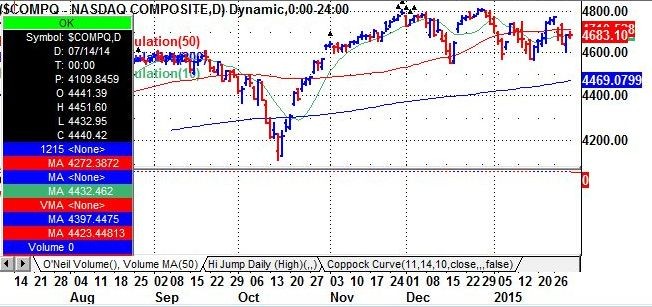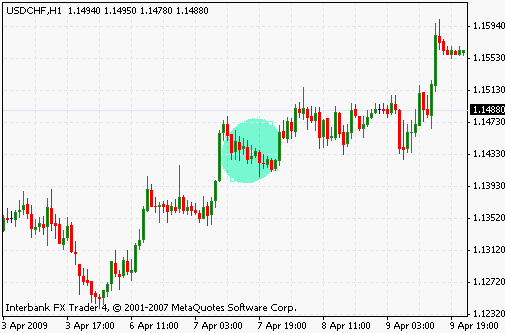Stocks are volatile but directionless
Post on: 20 Май, 2015 No Comment

LawrenceG. McMillan
Columnist
Editor’s Note: This is a free edition of MarketWatch Options Trader, a weekly MarketWatch subscriber newsletter. Click here for subscription information .
One trademark of this market is that extreme intraday volatility is the name of the game. Another trademark of this market is that one day seemingly has little or no influence on the next.
This week is a good illustration of these points. After a Monday rally that seemed somewhat lacking for participation, the bears came out in force on Tuesday. The Standard & Poor’s 500 Index SPX, +1.26% slammed down 37 points in early trading, only to rally nearly 28 from there. Late Tuesday afternoon selling pushed prices lower once again, but the market had one more trick: After the 4 p.m. close of trading, S&P futures jumped 7 points higher. So there was a 7-point discrepancy between the closing price of SPX and the closing price of the futures.
Then Apple AAPL, +1.81% reported monster earnings, and S&P futures traded up as much as another 16 points overnight. On Wednesday, though, that overnight euphoria gave way to even more selling, forcing SPX 40 points off its highs of the day. That kind of volatility hasn’t been common in recent years, but volatility indicators point to a continuation of the same (more about that later).
SPX has resistance at 2,065, both from earlier in the month and then from last week’s highs. Coming into today, SPX seemed to have support at 2,020, but that level was breached today. So the next support exists at 1,990. For now, SPX is in a trading range between 1,990 and 2,065. Outside of that range, there is further resistance at 2,090 (the all-time highs) and further support at 1,975 (the October lows). It will take a breakout from that wider range to establish new trend for SPX. However, it seems to me that a breakout from the inner 1,990-2,065 range will probably be enough to propel SPX right through those outer levels. So, the inner range is the one we consider most important at this time.
The graph of SPX also shows the “modified Bollinger Bands” (the wavy lines that surround the stock chart). You can see that SPX hasn’t yet traded down to the lower mBB. If it did, that would be the precursor to a strong buy signal. But that Band will move lower as SPX declines and volatility increases.
Both equity-only put-call ratios remain on sell signals. There’s been fairly heavy put buying lately, but not nearly as much as one might expect to see with SPX trading down sharply at time — as in the 37 point drop on Tuesday. In any case, the continued put buying is pushing the ratios higher, and that is bearish for stocks.
Market breadth has been fluttering back and forth, following the latest market movement on day and then reversing the next. For the record, both of the breadth oscillators that we follow are on sell signals after Wednesday’s action. What has been somewhat surprising on these volatile days where some large moves have occurred, is that there hasn’t been a single “90% day,” either in terms of advances and declines nor in terms of advancing versus declining volume.

No discussion of breadth is complete without mentioning cumulative breadth. Cumulative breadth is a running total of each days “advances minus declines.” The most accurate measure of cumulative breadth uses “stocks only” and not NYSE-based data, for the latter is replete with items that aren’t stocks. We measure “stocks only” breadth by looking at the total of advancing minus declining issues among optionable stocks. That measure of cumulative breadth made a new all-time high last July 3, as did SPX on the same day. Since then, cumulative breadth has declined, failing to generate any more new all-time highs, but SPX made new all-time highs on at least 50 days since then. This is a major, negative divergence. While the timing of these divergences can be hard to pin down, what we do know is that sell signals should not be ignored while this negative divergence is in place.
The CBOE volatility indexes (Volatility Index VIX, -8.60% S&P 500 3-Month Volatility Index VXV, -6.15% Mid-Term Volatility Index (VXMT) and Short-Term Volatility Index (VXST)) are all well off their mid-December and early January highs. There were a couple of VIX spike peak buy signals just after those peaks. VIX then declined below 14, and in doing so broke through its uptrend line. Those were all positive signs for stocks, but now VIX is moving higher again. Today, it closed above its moving average, and that changes things to a more bearish state. If VIX were to close above the early January highs, it would indicate a full-fledged sell signal for stocks.
The construct of VIX futures and of the CBOE volatility indexes has retained a fairly bullish picture, however. There is only a modest discount on the VIX futures, but the most positive thing is that both the futures and the Volatility Indices are displaying upward-sloping term structures. As long as that is the case, one must view the current market weakness as merely a correction and not yet the beginning of a bear market.
The fact that VXST (the short-term index) closed above VIX yesterday and is remaining above VIX today, is an indicator that the market will continue to be volatile. However, it is not necessarily a directional indicator, so that volatility could manifest itself either on the upside or the downside.
In summary, we have a “neutral” outlook for the market, since the indicators are mixed, and since SPX remains range-bound between support (1990) and resistance (2065). So, one can expect more volatility, but cannot necessarily expect a market price trend. A breakout from that trading range will lead to a strong, directional move.














